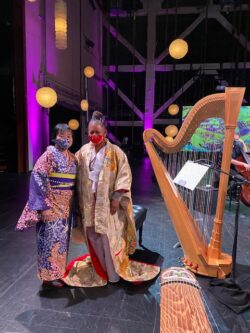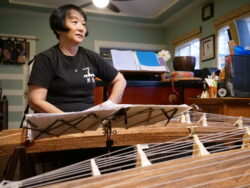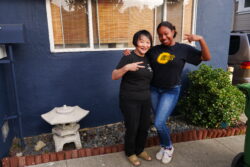
Listen to the songs
Click here to listen to the full program that Shirley curated and performed alongside the SF Symphony!
This fall, longtime ACTA mentor artist and master artist of the Japanese koto, Shirley Kazuyo Muramoto, was invited to curate an exchange between Western classical music and Japanese classical music by the San Francisco Symphony as part of their CURRENTS online program. What resulted was a beautiful episode featuring Shirley alongside San Francisco Symphony musicians in a program that celebrates the elegant power of an instrument to connect across genres.
Shirley titled the program ‘Niji’ 虹 (Rainbow), because “because it represents a rainbow of different people and different things in the Bay Area that (she’s) had the fortune to connect with and collaborate with and share music with.” A lifelong practitioner of the koto, a 13-stringed zither that is the national instrument of Japan, Shirley has participated in several ACTA programs, mentoring three different koto students through ACTA’s Apprenticeship Program. Shirley talked to ACTA Program Manager Lily Kharrazi about what the collaboration with the SF Symphony meant to her as a traditional culture bearer in the Bay Area.
The SF Symphony was looking to feature a collaboration between Japanese traditional music and classical music. Yuriko Fujita of the “Sharaku” store in SF Japantown—which sells Japanese music instruments and supplies—suggested me for the project to Casey Daliyo, who works in production at the SF Symphony. I have been performing and teaching Japanese koto in the Bay Area for over 60 years, so maybe that’s why Yuriko thought to suggest me for the project.

I was honored that the SF Symphony approached me to curate this episode. I have performed with several orchestras, so I had an idea what could work and what might not. Although they said I didn’t need to try and include symphony members in the pieces, I wanted to take this opportunity to work with the symphonic musicians. I know that the musicians of the SF Symphony are all excellent artists, so this was a wonderful opportunity to perform with them!
When I’m approached for different projects, I always look for ways to stretch the boundaries of koto music. This time, I chose more contemporary numbers that would appeal to western audiences. I also play jazz koto, so I thought it would be fun to try a jazz number with the orchestra, as well, something a little “outside the box” for both genres of music. Orchestral music and Japanese music are often looked upon as more classical, so a chance do an East/West jazz fusion performance was too tempting to pass up!
Koto was introduced from China as a part of the court ensemble music in the 8th century, and later began to be favored by wealthy aristocrats. By the 12th century, koto was also adapted to the Buddhist rituals to accompany songs. But it was only in the 16th century when the prototype of today’s koto music was developed with the innovation of the priest Kenjun. Koto music was further developed in the 17th century by a blind court musician named Yatsuhashi Kengyo, who studied koto from a disciple of Kenjun. Yatsuhashi began to teach koto to those outside of the nobility. He is considered the father of modern koto music. Yatsuhashi died the same year that Johann Sebastian Bach was born, in 1685.
I feel that there is a correlation of Japanese classical koto to Western European chamber music. Traditional koto music is sedate and elegant, reflective of its title as the national instrument of Japan.
Nowadays, you can hear koto in everything from folk songs to pop music which was definitely not the case until more recently. Pretty much, anything goes now.

I grew up playing traditional koto music, believing that the only kind of music that could be played on the koto was classical or what was composed by the main head master. Since koto music has this aristocratic background, it wasn’t easy to try and “break the mold,” so to speak. In the past, one was not allowed to even play music from another koto school. Things are a little more open these days, but there still is that feeling of loyalty to the school which is very important. To be asked to perform with a world renowned and highly decorated orchestra such as the SF Symphony can be thought of as performing “outside of the box,” in a way.
In my koto school, the Chikushi School, the founder of the school, Chikushi Katsuko, composed the first work for koto orchestra, symphonic orchestra and choir, called “Chikushi Ji.” So, performing in this way is a continuation of her vision. She also was an innovator. This was an opportunity to bring the koto further forward in my personal quest to make sure that the future of koto music in the United States continues.
My added incentive is to honor koto teachers who were imprisoned in the American concentration camps during WWII taught students while in camp, which included my mother. Because of their resolve and love of their art even in that unimaginable situation, I feel it’s my responsibility to make sure koto music continues in the U.S. in their honor.

When one practices traditional arts, one would hope that the core community where those arts come from would appreciate the arts of their heritage. I mentioned the history of Japanese Americans put into prisons during WWII including members of my own family. The stigma and the trauma felt by Japanese Americans of this time led them to feel they were not American enough. Many people from my community shunned Japanese cultural arts as they came out of the camps feeling that it was more important for them to prove they were loyal Americans by becoming “110% American.”
My hope is that this collaboration might bring respect and understanding to my own Japanese American community because these traditional arts are wonderful and beautiful.
That’s why I wore different kimono in each of the pieces I played, as well, to show the beautiful art of kimono. Also, as one who practices a traditional art, most of us traditional artists truly do love these arts, and that’s why we do them! We don’t expect any recognition or accolades. That’s why people who do traditional arts are so dedicated to them and have so much heart in them.
One concept which is different is having a conductor to guide the music. In Japanese music, it’s pretty much by feel, and musicians rehearse and rehearse so they know how the music is going to go without even looking up. When you’re playing the shamisen, you are not even to look at your hands on the neck.
Otherwise, the language of music is universal. There really isn’t anything to “translate” because it’s all in the feeling of the music, which is somehow understood.
Also, Japanese music themes are often around nature. The pieces we played, the translations were “Pastoral,” “Flow” of a river to a waterfall, and “Rainbow.” When I was learning violin, most of the music was “Opus 1,” “No. 3,” or something like that. But you can still hear feelings in the music even without a subject.
I love music from all around the world—East, West, North and South. I even varied the types of pieces in this episode: the first number was based on western scales; the second number was based on a Latin tuning; and the third number was based on an Asian pentatonic scale. I wouldn’t want to restrict myself because there are interesting and creative sounds from all over the globe. I am open to and have collaborated with many artists of the world in their music, dance and art, which keeps me creative and open and interested in my own music. I do try to work within the traditional tunings and techniques to keep the natural voice of the koto. Just here in the Bay Area, I have been able to collaborate with many diverse people and artists in this way, which is why I have lived here all my life.
Traditional arts are a little like studying history. When you study history, you get an idea how things came to be today, and what might be coming up in the future. Studying traditional arts is the foundation of a particular art practice and also a glimpse into the soul of a culture. Once you understand the sound and the words and the rhythms and how they came to be, it is more interesting and fun! Classical and traditional arts tell a story. You learn more about the people and the culture. Sometimes you understand it and sometimes you don’t, but music is a language of feeling. I don’t speak fluent Japanese so I don’t always know what all the words mean, but it doesn’t mean I can’t play it or sing it.
It doesn’t matter where you came from, even if it’s not part of your background. Anyone can understand it if you just listen.


Click here to listen to the full program that Shirley curated and performed alongside the SF Symphony!

Every gift is a commitment to a culture bearer, and the people of California.
DONATE